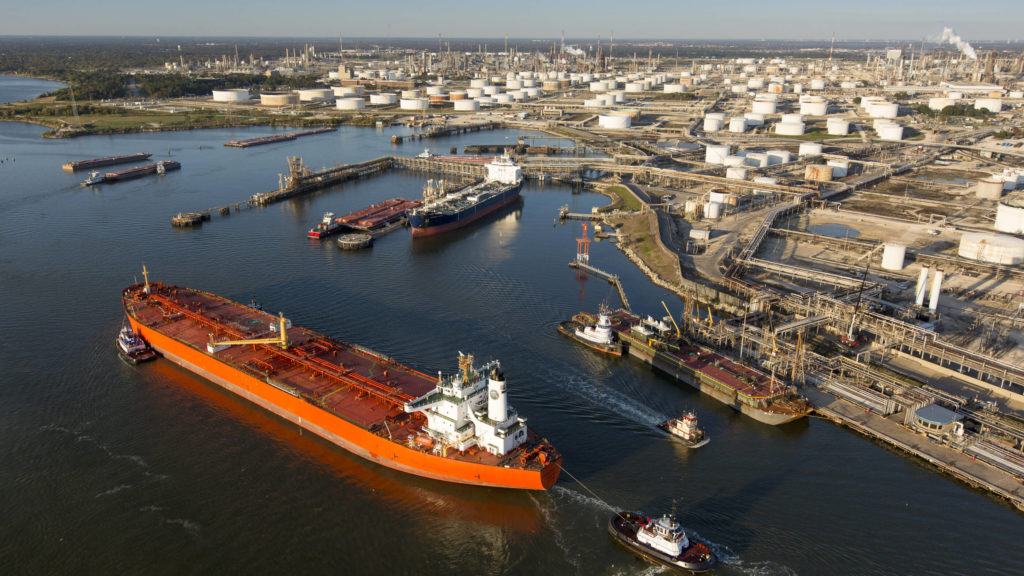- CCUS Basics
- The role of CCUS hubs
What is a CCUS hub?
A CCUS hub takes carbon dioxide from several emitting sources, such as heavy industries and power, and then transports and stores it using common infrastructure. A CCUS hub can be more complex to establish than a CCUS value chain on a single point source, managed by one company; but CCUS hubs bring many benefits, including lower unit costs, reduced risk and the ability to standardize and scale up quickly. For emitters, the hub offering opens up CCUS as a decarbonization option without them having to take responsibility for building pipelines and drilling storage wells and without long-term liability for the stored carbon dioxide.
Most CCUS hubs will be based around industrial clusters, where emission sources are close together, as in the East Coast Cluster or China’s Junggar Basin. But some will be geographically scattered, collecting emissions sources by pipeline or ship, as in Northern Lights in Norway and a series of planned hubs in the Asia-Pacific region.
- CCUS Basics
- The role of CCUS hubs
What are the pros and cons of a CCUS hub over a single project?
Faster scale up.
CCUS must expand rapidly to play a role in reaching climate goals. At present, the average large-scale CCUS project captures and stores around 1 Mt of carbon dioxide per year. Early CCUS hubs are aiming at around 5-10 Mt a year or more by 2030 and expect exponential growth. Future hubs are likely to be even larger.
Lower costs and investment risks.
Collective transport and storage infrastructure brings economies of scale in construction and operations, specifically in compression, dehydration, pipeline and storage. At the same time, shared lessons and standardization will bring down the costs of carbon capture and reduce risk. In the early stages of appraising potential new storage sites for hubs, sharing costs and risks make it simpler to get started in areas that have not been developed.
More government support.
A hub can decarbonize an entire industrial region, supporting jobs and attracting new clean industries. Such social and economic benefits buttress a hub’s contribution to meeting climate goals, increasing the likelihood that an individual project will gain government support. Efforts to create hubs in the UK, for example, have ensured that the government develops policy incentives for emitters and operators. The Norwegian and Dutch governments worked to change London Protocol regulations on the cross-border export of carbon dioxide, and both Northern Lights and Porthos – along with several associated emitters – have attracted large-scale EU funding. The Northern Lights JV has gained support from standard-setter Verra and emitting industries to take a new look at carbon accounting for CCUS and carbon removal, via the CCS+ Initiative.
Complexity.
This is the main disadvantage – and the reason we have set up this platform. A CCUS hub is a multi-stakeholder undertaking, which magnifies the need for careful communication and alignment between partners. Decisions on commercial relations, risk management and long-term investments must all be agreed between emitters, operators and government – who are all acting with different drivers and timescales. Countries that are pioneering hubs, such as the UK, Norway and the Netherlands, are building on years of frustrating attempts to get large-scale CCUS off the ground. They have learned lessons from these failures that they are now applying to make CCUS hubs a reality. Importantly, newcomers like Denmark and Malaysia have also taken these lessons on board to accelerate the implementation of CCUS hubs.
- CCUS Basics
- The role of CCUS hubs
What factors drive hub development?
Three conditions came together to enable the development of the earliest CCUS hubs in Norway, the UK and the Netherlands.
- Confidence that carbon storage exists and can be used, due to previous work on CCUS and the involvement of companies with subsurface and transportation experience.
- Northern Lights/Longship in Norway built on lessons learnt from over 20 years of experience storing carbon dioxide under the North Sea.
- The East Coast Cluster in the UK built on the White Rose project which selected the Endurance Reservoir now being used by the hub’s transport and storage operator, Northern Endurance Partnership.
- Porthos in the Netherlands is based on the ROAD project in the Port of Rotterdam, and carbon dioxide suppliers Shell and ExxonMobil have engaged their upstream subsurface engineers to build confidence in storage capacity.
- National and regional support to incentivize and build confidence for the large, high risk capital investments initially required.
- In Northern Lights/Longship, the Norwegian government has committed to national political objectives for CCUS and, in the first phase, is subsidizing 80% of investment costs for emitters and transport and storage infrastructure.
- In the UK’s East Coast Cluster, both regional and national authorities are politically committed to supporting the North’s industrial regions through the energy transition.
- In Porthos, the Port of Rotterdam wants to position itself as a clean industrial hub and national authorities are committed to industrial decarbonization.
- Understanding of the CCUS hub value proposition by a group of stakeholders involved in knowledge building and lobbying – smoothing the pathway and creating a broader ecosystem.
- Knowledgeable ministers have driven support at the top of the house. In Norway, governments and industry learned how to work together productively from failed attempts to start CCUS facilities in the 1990s.
- Industry associations have created synergies at lower levels – such as the Energy Technologies Institute and the Carbon Capture and Storage Association in the case of the UK clusters.
- Cross-national engagement between ministers and policy-makers from Norway, the UK and the Netherlands was crucial. They communicated frequently to exchange information, provide support and explore how a potential network of linked projects can be created to reduce costs and risks.
CCUS’s long history has been instrumental in building strong foundations for these early CCUS hubs, but other countries and hubs are building on these lessons – and learnings from introducing other clean technologies – to move far more quickly. This acceleration will be essential for CCUS hubs to fulfil their potential.
Denmark has taken just a few years to do what Norway, the UK and the Netherlands did over decades. CCUS was made legal in Denmark in 2020 as the government recognised its necessity for achieving a legally binding target to reduce greenhouse gas emissions by 70% by 2030 and reach carbon neutrality by 2050. Since then, the government has moved quickly to develop all three factors listed above. Specifically it:
Created confidence that carbon storage resources exist and can be used
- commissioned seismic studies covering the entire Danish storage resource both onshore and offshore
- streamlined storage permitting for four pilot projects
- tendered for carbon storage permits
- launched environmental impact assessments
Built national and regional support
- gained public, parliamentary and municipal support for CCS through the Danish Climate Agreement
- built public-private partnerships to launch hubs
- requested six cities to develop collaborative industrial cluster plans
Demonstrated the CCUS hub value proposition
- allocated €5 billion for CCUS and carbon removal projects
- introduced laws and signed agreements to allow cross-border trade of carbon dioxide
- introduced green taxation for industry
Denmark expects to start its first injections of 400,000 tonnes of carbon dioxide in 2025, with plans in place to reach 3 million tonnes by 2030. Danish storage capacity is estimated at 22 gigatonnes and the country sees itself as a carbon storage hub for Europe.
In North America, CCUS ecosystems have also developed in areas such as the US Gulf Coast and Alberta, where the Quest CCS facility has operated for over six years. In the US, CCUS evolved initially in relation to enhanced oil recovery projects, which resulted in both storage knowhow and pipeline infrastructure. Now, with significant support from the Department of Energy for projects, hubs and research and development, CCUS is increasingly being seen as a key part of low carbon business transformation for US industry.
- Multi-stakeholder coalitions have been responsible for developing and expanding the 45Q carbon storage tax credit through the US federal government legislative process and building knowledge among policymakers.
- Knowledge sharing by groups of emitters and potential hub developers, including OGCI, has also been crucial to get state-level support and regulations in place and to help industrial emitters understand the options.
- Competition between potential operators, eager to take first-mover advantage now that incentives are available, is now driving the industry.

You might also be interested in
- CCUS Basics
- The role of CCUS hubs
Where in the world are CCUS hubs possible?
OGCI is continually analyzing the global potential for CCUS hubs as part of the CCUS Hub Search tool. We have reviewed the potential for CCUS hubs in 52 countries, focusing on how much carbon dioxide can be captured and stored, and at what cost (techno-economic potential), as well as the environment of policy, regulation and commercial readiness.
Most of the 52 countries have potential CCUS hubs with cost levels below $100/tonne for capture, transport and storage, assuming existing technology costs. These span all world regions, and add up to 933 Mt of abatable annual emissions or around 2% of total emissions.
The most promising near-term opportunities are regions where high techno-economic potential meets a supportive environment. The Tool identifies 23 such potential CCUS hubs, representing 319 Mt of annual emissions that could be abated.

- CCUS Basics
- The role of CCUS hubs
Can CCUS hubs be set up even where there are no good local storage options?
Yes. Where there is no convenient storage site, it is possible to create a geographically distributed CCUS hub, with ships or a pipeline carrying carbon dioxide to a distant storage site. The cost of using ships for transport is more expensive on a large scale than a localized hub based on pipelines, but a shipping solution has two advantages: it supports the gradual development of a CCUS hub, and allows one storage facility to serve several smaller CCUS emission clusters.
The Northern Lights project in the North Sea is the most advanced example of a distributed hub and it is building ships that can safely carry large volumes of carbon dioxide. Several projects in Europe are looking at the potential of using multimodal carbon dioxide transport – road, rail, inland barges and maritime shipping, as well as pipelines – to offer services to new clusters of emission sources. These projects are disaggregating the CCUS value chain, creating nodes for collection, compression and temporary storage, or new transport operations. In 2023, the EU opened funding to cross border caarbon dioxide transport and storage infrastructure projects as part of its broader energy infrastructure strategy.
Hub projects in Asia are also exploring how to manage the mismatch between the concentration of industrial emissions and the availability of suitable storage sites. A consortium of six South Korean industrial companies, for example, is working with Petronas in Malaysia, to create a full carbon capture, transport and storage value chain between the two countries.
- CCUS Basics
- The role of CCUS hubs
Can CCUS hub support carbon removals?
Yes. Negative emissions, also known as carbon dioxide removal, require carbon dioxide to be taken out of the atmosphere and then stored. This is possible through various natural, hybrid and engineered approaches, and some of the most promising and scalable approaches involve CCUS technology.
Removals are already being built into hub concepts. At the East Coast Cluster, one power station will burn biomass, in a process known as bioenergy with carbon capture and storage (BECCS). Northern Lights is already collaborating with world leaders in direct air capture and BECCS technology.
In the US, a specific federal programme is providing $3.5 billion in support to set up four regional direct air capture (DAC) hubs, each storing at least a million tonnes of carbon dioxide per year. California, for one, has proposed an ambitious DAC hub in the state’s Central Valley.
Even CCUS hubs that don’t include carbon removal technologies will help indirectly, doing their bit to drive a massive scale-up of CCUS infrastructure. This will enable the kind of multi-gigatonne negative emissions that will be needed in the next few decades.


